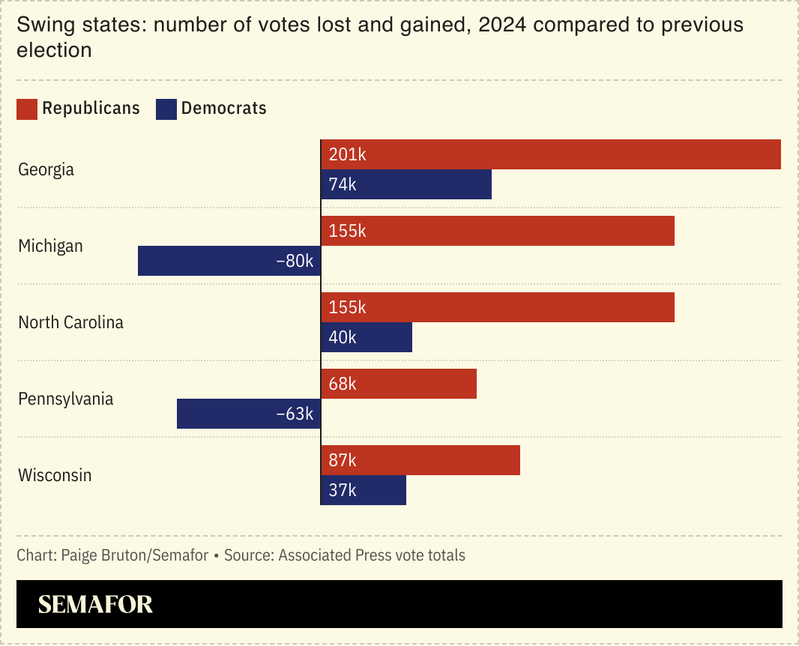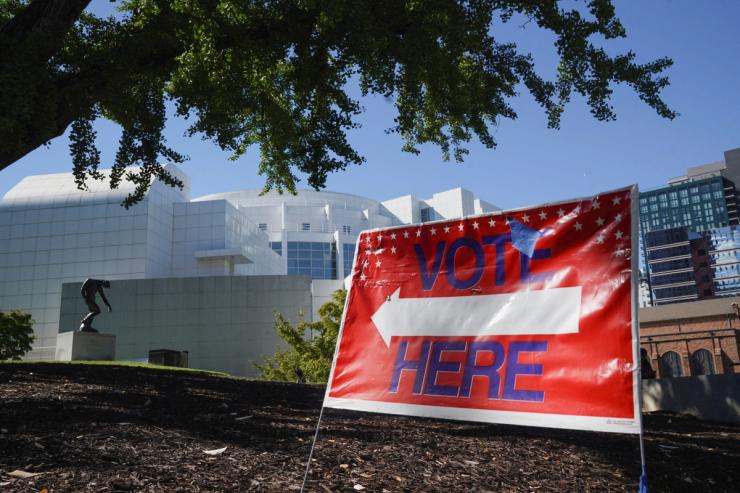The News
The vast majority of votes from this election have been counted, with just a few million ballots outstanding in western states. Total turnout is on track to fall just short of 2020, well ahead of some observers’ expectations on Election Night, when conspiracy theories about more than 10 million “missing Biden voters” flourished among Democrats.
Harris will win fewer votes than President Joe Biden did four years ago — but the decline was significantly steeper in safely red or blue states than in swing states. Where there was no national campaign spending on turnout, and where voters knew that they were unlikely to change the outcome, Harris ran further behind Biden.
Know More
In the 43 states (and D.C.) where neither campaign invested resources, there was an average 8-point shift toward the Republican ticket. In battleground states, the shift was 3 points.
The Harris campaign’s desperate strategy, of reconstituting a Biden coalition with fewer non-white voters and more college-educated white voters, came close to working — she lost by less than 2 points in the decisive Rust Belt states and only a little more in Georgia.
In four swing states, Harris was even able to win more raw votes than Joe Biden did four years ago: Georgia, Nevada, North Carolina, and Wisconsin. Adjusted for population growth, that didn’t mean much in the first three states, and Black turnout was disappointing enough to Georgia Democrats that Sen. Jon Ossoff is calling for a change in party leadership. But there was no overall decline in Democratic votes.
There was one in uncompetitive states. Trump ran stronger with non-white voters in big cities than any Republican nominee in decades. That performance looks even stronger because so many Biden voters, in places where they knew she would win, didn’t come back for Harris.
Harris won Illinois by just 10 points, the smallest win margin for a Democratic presidential candidate in 20 years. As of Friday morning, Trump had added just 29,532 votes to his 2020 total, but Harris had run 514,017 votes behind Biden. In Chicago’s Cook County, the Trump electorate grew by just 12,448 in four years, while Harris earned 350,524 fewer votes than Biden.
That didn’t happen in Milwaukee, a short drive (or Amtrak ride) north. Democrats poured resources into turnout, into a place where voters expected (and got) their third consecutive presidential election decided by less than 1 percentage point. Trump added just 3,827 votes, after holding the RNC in Milwaukee itself; Harris ran just 1,271 votes behind Biden. In Madison’s Dane County, Trump improved by 6,655 votes, but Harris improved, too, winning 13,833 more votes than Biden. And because Trump improved more dramatically over his 2020 performance outside of cities and suburbs, he narrowly won the state.

He did even better in some states he didn’t win. Trump’s gains in New York were driven by two things — more votes from non-white New Yorkers in the five boroughs and their suburbs, and a steep decline of Democratic votes. In New York City itself, Trump added 95,594 votes from 2020 to 2024. One in four of those new votes came in the Bronx, a testament to his breakthrough with Latino men.
But the Democratic fall-off was more dramatic. Harris won 573,622 fewer votes in the city this year than Biden did in 2020. That wasn’t just about traditional Democrats switching to Trump. Hundreds of thousands of New Yorkers opted not to support Harris, some leaving the top of their ballots blank.

Notable
In the New York Times, Thomas B. Edsall looks more deeply at the constituencies that moved away from Democrats: “Republican success or failure in building a more durable coalition will depend in large part on how the public reacts to the policies adopted during Trump’s second term.”
In Larry Sabato’s Crystal Ball, J. Miles Coleman examines the races where there were significant gaps between voters’ presidential choices and their down-ballot choices. “In blue counties, Senate Democrats performed better than Harris, while the reverse is true in red counties.”


